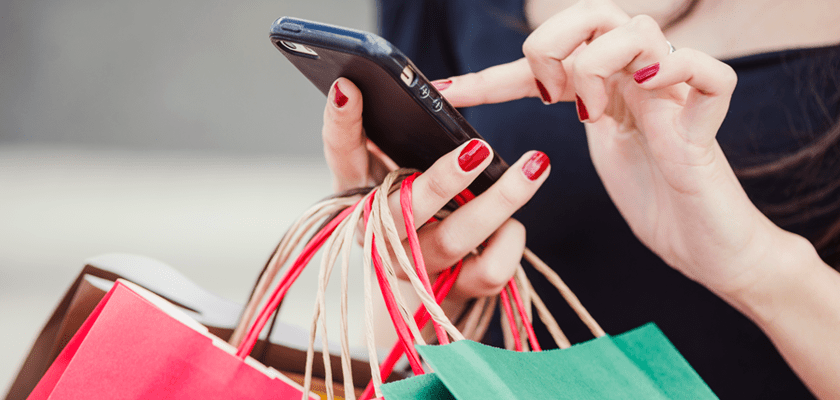5 Inspiring Retail App Trends to Drive Mobile Sales

Mobile commerce is becoming an increasingly important part of the consumer buying process.
Forrester’s Retail Best Practices study found that mobile phones were used for research, price comparisons or to make purchases in one-third of U.S. retail sales in 2018 (which amounted to more than $1+ trillion). Forrester anticipates mobile shopping sales will grow 18% annually over the next five years.
To make sure your mobile app is enhancing your customers’ shopping experience, we’re sharing some key ecommerce trends in the retail app space—including examples from top brands—to inspire your ecommerce strategy.
Download our Retail Guide for a deeper dive into our top shopping app trends.
1. Creating Flexible App Onboarding Processes for Users
Most commerce app developers struggle to get first-time users to learn about key features, grant access to their data and set up an account before they abandon the process.
The challenges associated with these linear onboarding flows have inspired some retailers to try a different approach: instead of forcing new users through a step-by-step funnel, they’re embedding traditional onboarding prompts into relevant areas of the app. Letting users skip the traditional onboarding process means they can discover the value the app has to offer on their own terms. Plus, they learn why sharing personal data will improve their experience where it has the most context.
Adidas’ first-time user experience is a perfect example of giving users the freedom to freely explore the app—while still encouraging them to grant access to their data so the app can be tailored to their preferences.

When users first open the app, they’re presented with a single splash screen that includes an optional three-screen tutorial. After that, users can immediately browse products in the app. However, the home screen cleverly encourages users to share their location, shopping preferences, and birthday by embedding benefit-drive requests for data between products and other content. Once users share their interests, they’re served personalized recommendations.
Showing users the value they’ll gain from opting in before the app requests access has a higher chance of increasing opt-in rates compared to traditional pop-up prompts.
Shopping app onboarding trends to consider:
- Make steps in your onboarding optional or skippable.
- Let users immediately start exploring your app as soon as possible.
- Embed benefit-driven requests for access to mobile users’ data into various parts of your app.
2. Personalizing the Shopping Experience Across Channels & Devices
According to Google research, 85% of online shoppers start a purchase on one device and finish on another. That’s why forward-thinking brands are re-engaging shoppers by surfacing personalized content to users across devices and channels. They do this by sending customers relevant messages, offers, and content based on their web browsing, mobile app activity, and in-store purchases.
Sephora ensures cross-channel personalization for their members through their Beauty Insider program, which tracks user activity across web, mobile, and brick-and-mortar stores. This information is then used to send tailored product recommendations, and change what the user sees when browsing Sephora’s website.

Retail personalization tactics to consider:
- Serve customized recommendations via email, web, mobile app inbox or home screen, and push or SMS messages.
- Create promotional content that matches browsing, search, and purchasing history across channels.
- Personalize campaigns based on customer behavior like number of purchases, total revenue, subscription type, etc., or personal attributes and preferences.
3. Blending In-Store & Mobile Experiences To Help Buyers Make Decisions
Mobile apps are increasingly being designed to complement and enhance the in-store shopping experience, with the intention of driving sales in stores and on digital channels.
For example, many shopping apps now include more product information—such as pairing suggestions, customer reviews, and how to videos—to make user research in-store easier and increase the likelihood of purchase.
Walmart’s mobile app includes a barcode scanner so shoppers can do price checks and surface more information in-store. However, it can also be used by customers to make an online order from their home. For example, app users can scan an empty tube of their favorite hand cream to order the item online or send to a nearby store for pickup.

The app also gives users local deal flyers so they can coax customers to come to nearby stores or check out the weekly specials if they’re already in the store.

Another way mobile apps are giving customers an in-store experience at home is through AR shopping tools. In Sephora’s app, users can try on products using their phone’s camera and put items directly into their mobile shopping cart.

Retail app trends to consider:
- Expand product info in-app to include more social proof (reviews, user photos, etc.) and additional product information that may be useful in-store or at home.
- Use scanners and virtual “try on” features to make buying more interactive—whether users are in a store or at home.
- Use location-based content to help drive customers to nearby stores.
4. Increasing Mobile Conversions With Frictionless Checkout
Mobile cart abandonment rates are alarmingly high at 85.65%. Pinpointing the reasons for cart abandonment can be tough. Everything from lengthy checkout processes to the absence of user reviews, a guest checkout option or security features can cause users to drop off.
This is why improving and simplifying the mobile checkout flow through incremental A/B testing is often the best way to discover areas for improvement. Experimenting with the number of checkout steps, required fields, and copy or visuals are often helpful starting points.
Free Download: Get a list of the top mobile A/B tests for retail apps.
Best Buy’s mobile app checkout is an excellent example of a simple check-out design. The app gives users the option to check out as a guest (which can reduce friction) and shows them a progress bar to ease impatience. It also doesn’t feature any visual distractions.
They also offer an option to call their support lines for help. Popups offering chat or phone assistance are growing in popularity in retail apps, so consider placing support information nearby to help users complete their purchase.

Online checkout A/B tests to consider:
- Test the number of checkout steps and fields to see where the process can be simplified (and implement a progress bar to ease user anxiety).
- Remove distractions like navigation or recommendations (but experiment with positive user reviews and other forms of social proof).
- Make CTAs for live chat or phone support prominent to help get buyers over the finish line.
5. Re-engaging Customers With Creative, Customized Push Notifications
Push is still one of the most effective ways to re-engage mobile users. However, it’s crucial that push notifications stand out amongst competitors and don’t annoy users.
To overcome these obstacles, brands are sending timely, creative rich push notifications. These notifications use emojis, images (including GIFs) and fun copy to engage shoppers.

Retailers are also using hyper-targeted messages to grab users’ attention. Push campaigns based on past purchases, favorite categories, and more can help retain shoppers.

With the right segmentation capabilities, you can also set up push triggers based on things like location, days since last login, and other user behaviors.

Push Notification campaigns for retailers to consider:
- Incorporate images (including GIFs), emojis and creative copy to make your push notifications noticeable.
- Create personalized campaigns based on past user purchases, favorited items, etc.
- Send geo-triggered messages when customers walk by a store.
Download our Retail Guide to learn how you can quickly implement these ideas in your mobile app with Taplytics—from targeted offers, personalized push notifications, and more.
Photo from freepik.com.
